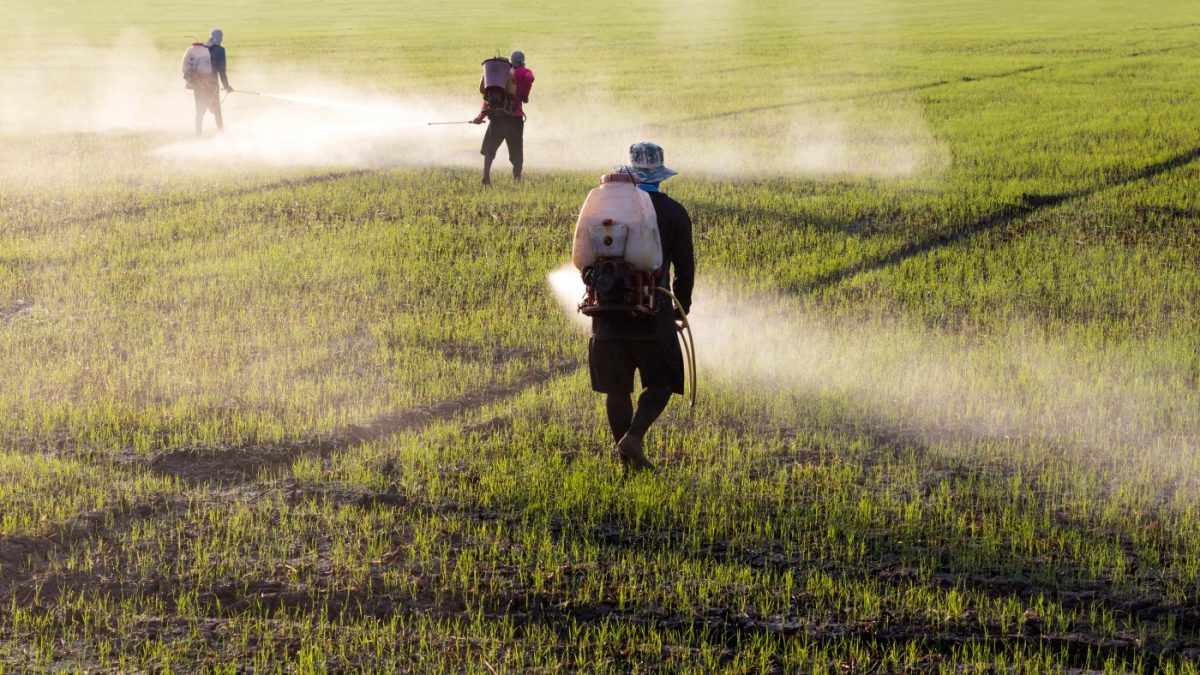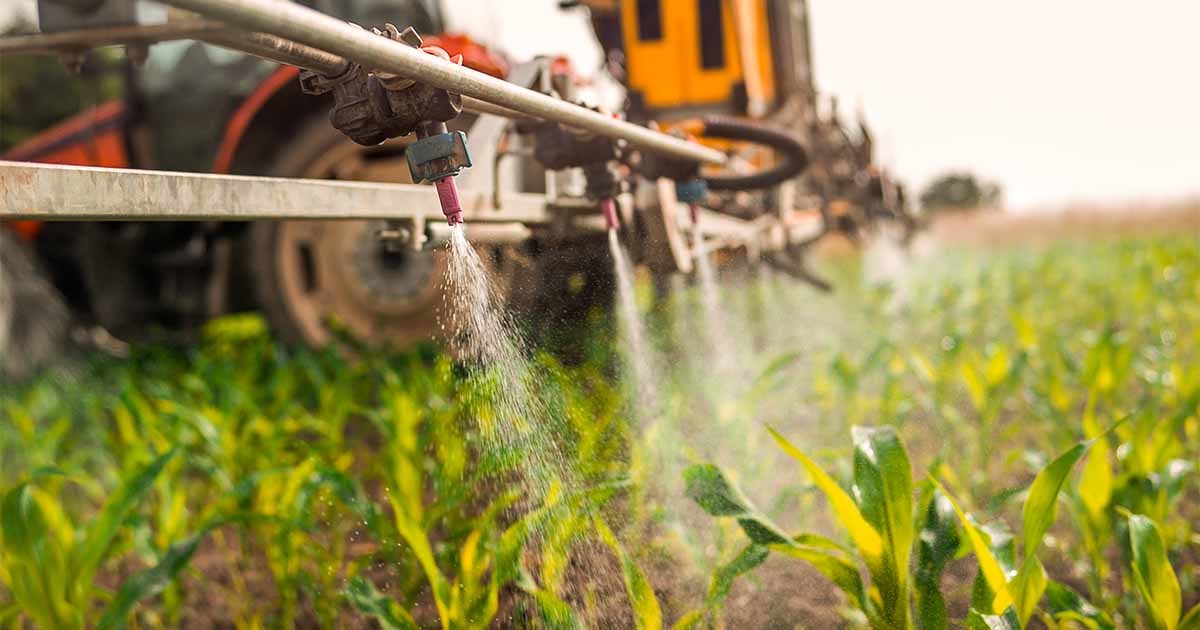Home>Gardening News and Trends>Latest News>Which Pesticides Cause Parkinson’s Disease


Latest News
Which Pesticides Cause Parkinson’s Disease
Modified: January 22, 2024
Stay updated with the latest news on pesticides linked to Parkinson's disease and learn which specific pesticides have been identified as potential causes.
(Many of the links in this article redirect to a specific reviewed product. Your purchase of these products through affiliate links helps to generate commission for Chicagolandgardening.com, at no extra cost. Learn more)
Table of Contents
Introduction
Welcome to our comprehensive guide on the link between pesticides and Parkinson’s disease. Parkinson’s disease is a neurological disorder that affects millions of people worldwide, causing a range of physical and cognitive symptoms. Over the years, research has indicated a potential connection between exposure to certain pesticides and the development of Parkinson’s disease.
Parkinson’s disease is a progressive disorder that primarily affects the brain’s ability to control movement. Individuals with Parkinson’s often experience tremors, stiffness, and difficulty with balance and coordination. In addition to these physical symptoms, many patients also experience cognitive impairments, such as memory loss and difficulties with thinking and problem-solving.
While the exact cause of Parkinson’s disease is still unknown, several studies and scientific research have suggested that exposure to certain pesticides may increase the risk of developing the condition. Pesticides are chemical substances commonly used in agriculture, landscaping, and food production to control pests and weeds. However, these chemicals can also have harmful effects on human health when not used properly or in excessive amounts.
It is important to note that not all pesticides are linked to Parkinson’s disease. The association is primarily observed with specific classes of pesticides, such as herbicides, insecticides, and fungicides. Understanding the potential links between these pesticides and Parkinson’s disease can help individuals and communities take necessary precautions to minimize exposure and reduce the risk of developing this debilitating condition.
In the following sections, we will delve deeper into the relationship between pesticides and Parkinson’s disease, exploring the common pesticides associated with the condition and discussing prevention measures that can be taken to safeguard against exposure.
Understanding Parkinson’s Disease
Parkinson’s disease is a neurodegenerative disorder that primarily affects the dopamine-producing neurons in the brain. Dopamine is a neurotransmitter responsible for transmitting signals between brain cells and playing a crucial role in coordinating movement. When these neurons become damaged or die, the brain is unable to produce adequate amounts of dopamine, leading to the motor and non-motor symptoms associated with Parkinson’s disease.
The exact cause of Parkinson’s disease is still not fully understood. While most cases are idiopathic, meaning the cause is unknown, researchers believe that a combination of genetic and environmental factors contribute to its development. Environmental factors, such as exposure to certain chemicals, including pesticides, have gained attention in recent years as potential risk factors for Parkinson’s disease.
Studies have shown that individuals living in rural areas, particularly those involved in farming and agriculture, are at a higher risk of developing Parkinson’s disease. This observation has led researchers to investigate the impact of pesticides on the onset and progression of the disease. Pesticides are known to be toxic substances designed to target and eliminate pests, but they can also be harmful to human health when not handled and used properly.
It is important to note that not everyone exposed to pesticides will develop Parkinson’s disease, as genetics and individual susceptibility also play a role. However, research has suggested a correlation between long-term exposure to certain pesticides and an increased risk of developing the disease.
Parkinson’s disease is characterized by both motor and non-motor symptoms. Motor symptoms include tremors, bradykinesia (slowed movements), rigidity, and postural instability. Non-motor symptoms may include cognitive impairments, such as memory decline and difficulties with concentration, as well as mood disturbances, sleep disturbances, and autonomic dysfunction.
As the disease progresses, these symptoms may worsen, impacting the individual’s quality of life and daily functioning. While there is currently no cure for Parkinson’s disease, various treatment options, including medication, physical therapy, and lifestyle changes, can help manage symptoms and improve quality of life.
In the next sections, we will explore the specific pesticides that have been associated with Parkinson’s disease, providing insight into the potential risks and how to minimize exposure to these chemicals.
The Link Between Pesticides and Parkinson’s Disease
Extensive research has revealed a potential link between exposure to certain pesticides and the development of Parkinson’s disease. Pesticides are chemical compounds used to control pests and unwanted plants in various agricultural, residential, and industrial settings. While pesticides are beneficial for protecting crops and ensuring food security, their potential adverse effects on human health have become a significant concern.
The association between pesticides and Parkinson’s disease stems from the fact that many pesticides have neurotoxic properties. These chemicals can interfere with the normal functioning of the brain’s dopamine system, which is compromised in Parkinson’s disease. Exposure to pesticides may damage dopamine-producing neurons or disrupt dopamine receptors, leading to the development of Parkinson’s-like symptoms.
Several epidemiological studies have demonstrated a higher prevalence of Parkinson’s disease in individuals with occupational exposure to pesticides, such as farmers, pesticide applicators, and agricultural workers. Furthermore, people residing in close proximity to farms or areas with intensive pesticide use may also be at an increased risk.
Various pesticides have been implicated in the development of Parkinson’s disease. These include herbicides, insecticides, and fungicides, each with its own specific mode of action and potential neurotoxic effects. Chemicals such as paraquat, rotenone, and maneb/mancozeb have received particular attention for their involvement in Parkinson’s disease.
It is important to note that the mechanisms by which pesticides contribute to Parkinson’s disease are complex and not fully understood. Some pesticides may directly damage dopamine neurons, while others may induce oxidative stress, inflammation, or mitochondrial dysfunction in the brain, all of which can contribute to neurodegeneration.
Furthermore, research suggests that certain individuals may have a genetic predisposition that increases their susceptibility to the neurotoxic effects of pesticides. Variations in specific genes related to pesticide metabolism and detoxification pathways may determine an individual’s ability to eliminate these chemicals from their system, thereby influencing their risk of developing Parkinson’s disease.
Overall, the link between pesticides and Parkinson’s disease highlights the importance of taking precautions to reduce exposure to these harmful chemicals. While more research is needed to fully understand the mechanisms involved and the specific pesticides that pose the greatest risk, it is advisable to minimize exposure to pesticides whenever possible.
In the following sections, we will explore the common pesticides associated with Parkinson’s disease, providing insights into their use, potential risks, and safety measures that can be taken to protect oneself from exposure.
Common Pesticides Associated with Parkinson’s Disease
Several classes of pesticides have been linked to an increased risk of Parkinson’s disease. Understanding these common pesticides and their potential impact can help individuals make informed decisions and take necessary precautions to reduce exposure. Here are some of the most widely mentioned pesticides in relation to Parkinson’s disease:
Herbicides:
- Paraquat: Paraquat is a widely used herbicide known for its potent weed-killing properties. Studies have shown that long-term occupational exposure to paraquat increases the risk of Parkinson’s disease development. The mechanisms by which paraquat contributes to Parkinson’s disease are thought to involve oxidative stress and damage to dopamine-producing neurons.
- Glyphosate: Glyphosate is the active ingredient in many herbicides, including the popular weed killer Roundup. While the link between glyphosate and Parkinson’s disease is still under investigation, some studies suggest a potential association. Further research is needed to fully understand the impact of glyphosate on Parkinson’s disease development.
Insecticides:
- Organophosphates: Organophosphates are a class of insecticides commonly used in agriculture and public health to control pests. Long-term exposure to organophosphates has been associated with an increased risk of Parkinson’s disease. These pesticides can interfere with the normal functioning of the nervous system, including the dopamine system, potentially leading to neurodegeneration.
- Pyrethroids: Pyrethroids are synthetic insecticides widely used in residential and agricultural settings. Some studies suggest a possible link between pyrethroid exposure and Parkinson’s disease, although the evidence is not yet conclusive. Pyrethroids work by targeting the nervous system of insects, and long-term exposure may affect the human nervous system as well.
Fungicides:
- Maneb/Mancozeb: Maneb and mancozeb are fungicides commonly used in agriculture to control fungal diseases. Several studies have found an association between these fungicides and increased risk of Parkinson’s disease. The exact mechanisms by which manebe and mancozeb contribute to neurodegeneration are still being investigated, but they can potentially disrupt the dopamine system and induce oxidative stress.
It is important to note that the impact of these pesticides on Parkinson’s disease can vary depending on factors such as the duration and intensity of exposure, individual susceptibility, and specific genetic variations. Additionally, other pesticides not mentioned here may also play a role in Parkinson’s disease development.
Reducing exposure to pesticides is crucial in minimizing the risk of Parkinson’s disease. This can be achieved through adopting sustainable and organic farming practices, using alternative pest control methods, and implementing safety measures such as wearing protective clothing and equipment when working with pesticides.
In the next section, we will discuss prevention and safety measures that can be taken to reduce exposure to pesticides and protect against the development of Parkinson’s disease.
Herbicides
Herbicides are chemicals used to control and eliminate unwanted plants, commonly known as weeds. While herbicides are beneficial for maintaining crops and landscapes, certain herbicides have been associated with an increased risk of Parkinson’s disease. It is important to understand the potential risks and take necessary precautions to minimize exposure to these herbicides.
Paraquat:
Paraquat is a highly toxic herbicide widely used in agriculture and commercial settings. It is known for its rapid weed-killing action and is commonly used to control various broadleaf weeds and grasses. However, multiple studies have found a strong association between paraquat exposure and the development of Parkinson’s disease.
The mechanisms by which paraquat contributes to Parkinson’s disease are not fully understood. However, it is believed to induce oxidative stress in the brain, leading to damage to dopamine-producing neurons. The oxidative stress caused by paraquat can trigger inflammation and impair the normal functioning of the dopaminergic system, ultimately leading to neurodegeneration.
Due to its toxic nature, several countries have banned or restricted the use of paraquat. However, it is still used in many regions. Occupational exposure to paraquat, particularly among agricultural workers and pesticide applicators, has been strongly linked to an increased risk of developing Parkinson’s disease.
Glyphosate:
Glyphosate is the active ingredient in many herbicides, including the well-known product Roundup. While glyphosate itself has not been directly linked to Parkinson’s disease, there have been concerns about its potential role in the development of the condition.
The debate surrounding glyphosate and its association with Parkinson’s disease is ongoing, with conflicting scientific evidence. Some studies suggest a positive association, while others indicate no significant link. Further research is needed to better understand the potential health effects of long-term glyphosate exposure.
It is worth noting that glyphosate is commonly used in agriculture, landscaping, and residential areas. Therefore, it is advisable to use precautions when handling glyphosate-based herbicides. This includes wearing protective clothing, gloves, and a mask, as well as following proper application techniques and safety guidelines.
Overall, the use of herbicides, particularly paraquat and glyphosate, has raised concerns about their potential impact on Parkinson’s disease development. Minimizing exposure to herbicides through safe handling practices, adopting alternative weed control methods, and promoting sustainable agricultural practices can help reduce the risks associated with these chemicals.
In the next section, we will explore insecticides and their potential implications for Parkinson’s disease.
Insecticides
Insecticides are chemical substances used to control and eliminate insects that pose a threat to crops, public health, or property. While insecticides play a crucial role in pest management, certain types of insecticides have been linked to an increased risk of Parkinson’s disease. Understanding the potential risks and taking necessary precautions can help minimize exposure to these insecticides.
Organophosphates:
Organophosphates are a commonly used class of insecticides in agricultural and residential settings. They work by disrupting the nervous system of insects, but they can also be harmful to humans. Research has shown a link between long-term occupational exposure to organophosphates and an increased risk of Parkinson’s disease.
Organophosphates inhibit an enzyme called acetylcholinesterase, which leads to a buildup of the neurotransmitter acetylcholine. This disruption in the nervous system can affect dopamine-producing neurons and contribute to the development of Parkinson’s disease symptoms.
Pyrethroids:
Pyrethroids are synthetic insecticides widely used in both agricultural and residential settings. While pyrethroids are generally considered safer than organophosphates, there is still concern about their potential impact on Parkinson’s disease.
Studies investigating the association between pyrethroid exposure and Parkinson’s disease have produced mixed results. Some studies suggest a possible link, while others have not found a significant association. The potential neurotoxic effects of pyrethroids on the human nervous system, including the dopamine system, are still being investigated.
It is worth noting that individuals with occupational exposure to insecticides, such as farmers, pesticide applicators, and pest control workers, are more likely to be at risk for Parkinson’s disease. Additionally, people living in close proximity to agricultural regions where insecticides are heavily used may also face an increased risk.
Minimizing exposure to insecticides can be achieved by adopting integrated pest management (IPM) strategies, which aim to control pests using a combination of biological, cultural, and chemical methods. This approach focuses on reducing the reliance on insecticides and using them only when necessary.
Wearing appropriate personal protective equipment, such as gloves and masks, when working with or around insecticides is essential to reduce exposure. Following label instructions, storing insecticides safely, and avoiding direct contact with treated surfaces can further minimize risks associated with these chemicals.
Overall, while insecticides serve an important role in pest control, it is vital to exercise caution and take necessary precautions to minimize exposure. By implementing safe handling practices and exploring alternative pest management methods, individuals can reduce the potential risks associated with insecticide exposure and support their overall health and well-being.
In the next section, we will explore the use of fungicides and their potential implications for Parkinson’s disease.
Fungicides
Fungicides are chemical substances used to control and eliminate fungal diseases that can damage crops, plants, and trees. While fungicides are essential for protecting agricultural yields and maintaining plant health, some types of fungicides have been associated with an increased risk of Parkinson’s disease. Understanding the potential risks and taking necessary precautions can help minimize exposure to these fungicides.
Maneb/Mancozeb:
Maneb and mancozeb are commonly used fungicides in agriculture to control fungal infections in crops. These fungicides have been the focus of several studies due to their potential involvement in the development of Parkinson’s disease.
Research suggests that long-term occupational exposure to maneb and mancozeb is associated with an increased risk of Parkinson’s disease. These fungicides can penetrate the blood-brain barrier and affect the brain’s dopaminergic system, leading to neurodegeneration.
Maneb and mancozeb may also induce oxidative stress in the brain, which can contribute to the damage of dopamine-producing neurons. The combination of altered dopamine levels and oxidative stress is thought to play a role in the development of Parkinson’s disease symptoms.
Other Fungicides:
While maneb and mancozeb have received significant attention, other fungicides have also been explored for their potential connection to Parkinson’s disease. More research is needed to fully understand their impact on human health.
It is important to note that fungicides come in various formulations, and their potential health effects may vary depending on the specific active ingredients and their concentration. As such, it is important to follow label instructions carefully and wear proper protective gear when handling fungicides to reduce exposure.
Minimizing exposure to fungicides can be achieved by adopting alternative disease management strategies, such as crop rotation, planting disease-resistant varieties, and optimizing cultural practices to create a favorable growing environment that reduces the need for chemical interventions.
Additionally, individuals working in agriculture or those who live in proximity to agricultural areas should be aware of the potential risks associated with fungicides and take precautions to limit exposure. This includes avoiding direct contact with treated crops or plants, adhering to proper disposal methods for containers and unused fungicides, and seeking guidance on safe handling practices.
By understanding the potential risks of fungicides and implementing appropriate safety measures, individuals can minimize their exposure and reduce the potential impact on their health and the development of Parkinson’s disease.
In the next section, we will discuss prevention and safety measures that can be taken to reduce exposure to pesticides and protect against the development of Parkinson’s disease.
Prevention and Safety Measures
Preventing and minimizing exposure to pesticides is key to reducing the potential risk of developing Parkinson’s disease. Whether working in agricultural settings, handling pesticides, or residing in areas where pesticide use is prevalent, taking the following safety measures can significantly reduce the risk of exposure:
1. Education and Awareness:
Stay informed about the potential risks associated with pesticides and their connection to Parkinson’s disease. Stay up-to-date on the latest research and guidelines from reputable sources, such as government health agencies and scientific institutions.
2. Integrated Pest Management (IPM):
Implement integrated pest management strategies that focus on prevention, monitoring, and the use of non-chemical control methods. Utilize biological controls, crop rotation, and cultural practices to reduce the reliance on pesticides.
3. Personal Protective Equipment (PPE):
Wear appropriate personal protective equipment, such as gloves, long-sleeved shirts, long pants, and respiratory protection, when handling or applying pesticides. This helps minimize contact and inhalation of potentially harmful chemicals.
4. Proper Handling and Application:
Follow label instructions carefully when handling and applying pesticides. Use the recommended dosage, avoid overuse, and take precautions to prevent drift or contamination of nearby areas. Store pesticides securely and dispose of empty containers according to local regulations.
5. Safe Work Practices:
Employ safe work practices, such as washing hands thoroughly after handling pesticides, washing work clothes separately from regular laundry, and showering after pesticide application. This helps minimize the risk of residual pesticide exposure.
6. Protective Measures at Home:
Limit exposure to pesticides at home by using natural or organic alternatives for pest control whenever possible. Keep windows closed during times of heavy pesticide application in the vicinity and consider air filtration systems to reduce indoor pesticide exposure.
7. Community Efforts:
Advocate for stricter regulations on pesticide use and support community initiatives promoting sustainable and organic farming practices. Participate in local pesticide monitoring programs and encourage dialogue on pesticide safety measures within your community.
By adopting these prevention and safety measures, individuals can significantly reduce their exposure to pesticides and minimize the potential risks associated with the development of Parkinson’s disease. It is essential to prioritize health and safety when working with or near pesticides, both at the individual level and within the broader community.
While these measures can help in reducing risk, it is important to consult with healthcare professionals for personalized advice and guidance specific to your circumstances.
Conclusion
The link between pesticides and Parkinson’s disease has garnered significant attention in the research and medical communities. While the exact mechanisms by which pesticides contribute to the development of Parkinson’s disease are still being investigated, evidence suggests that certain pesticides, such as herbicides, insecticides, and fungicides, may increase the risk.
Understanding the potential risks associated with pesticide exposure is crucial for individuals working in agricultural settings, as well as those residing in areas where pesticide use is prevalent. It is important to take necessary precautions to minimize exposure, such as following safe handling practices, using personal protective equipment (PPE), adopting integrated pest management (IPM) strategies, and promoting sustainable agricultural practices.
Education and awareness play a vital role in preventing and reducing pesticide-related risks. Staying informed about the latest research, guidelines, and regulations can empower individuals to make informed decisions regarding pesticide use and minimize potential health hazards.
While the connection between pesticides and Parkinson’s disease is evident, it is also important to acknowledge that Parkinson’s disease is a complex condition influenced by various factors, including genetics and environmental exposures beyond pesticides. Each individual’s susceptibility to the disease may vary, and not everyone exposed to pesticides will develop Parkinson’s.
In conclusion, by prioritizing prevention, practicing safe handling and usage of pesticides, and promoting sustainable and alternative pest management methods, individuals can reduce their exposure to pesticides and potentially mitigate the risk of developing Parkinson’s disease. Continued research, public education, and advocacy for safer pesticide use are crucial in protecting human health and well-being while ensuring the sustainability of agricultural practices.








